Slip Stitch Dishtowels In Blackbird Linen
Hand-knit kitchen textiles bring love to the stirring of lemon risotto as much as the baking of mac ‘n cheese!
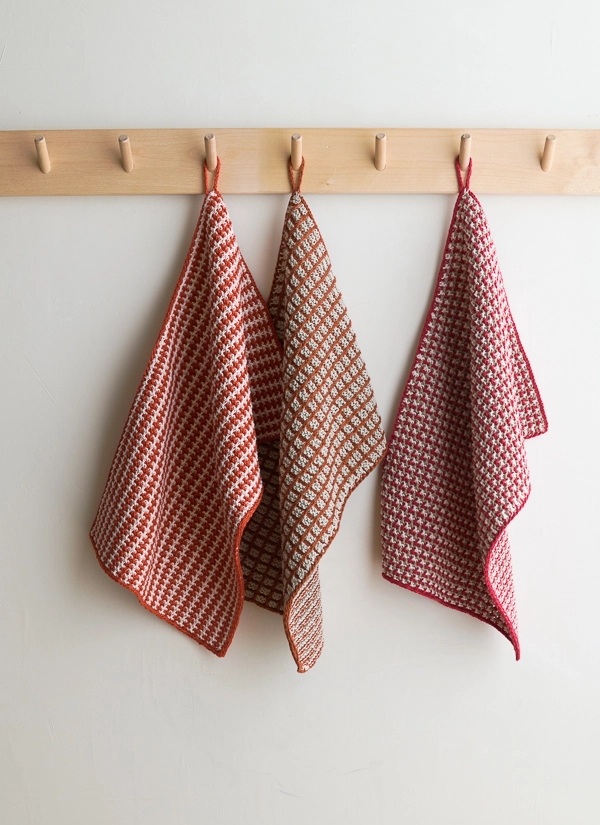
For sure, there is power in these Slip Stitch Dishcloths: the revelation of having made them yourself, as well as the joy in their beauty.
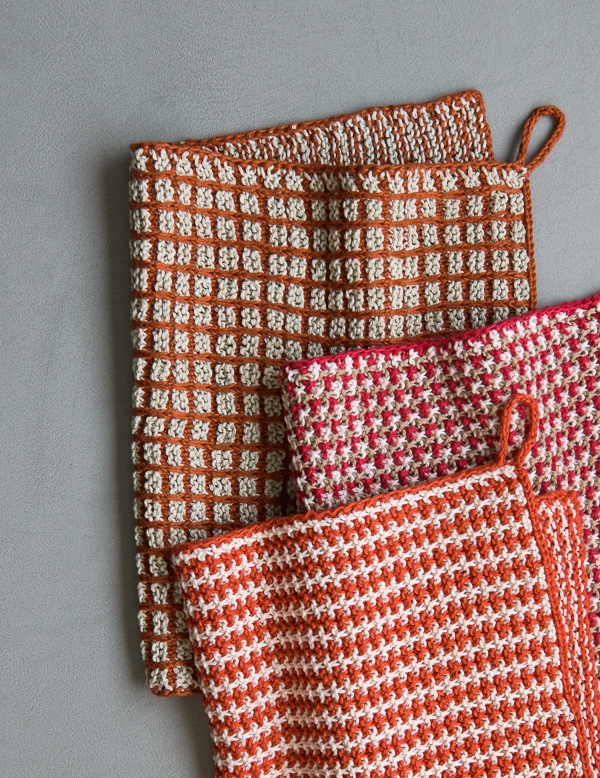
Perhaps you agree but are thinking there’s just one small problem, “There’s no way I could ever knit those!” Wrong! Slip stitches are knitting’s secret weapon for easy-as-pie colorwork. You only ever work one color per row, letting the magic of slipping stitches do its thing… Really!

Of course there’s no point if your dishtowels aren’t as strong as an ox, machine washable, and absorbent, too. To fulfill these requirements, we used our new Blackbird Linen. Like the wing of a blackbird catching the early morning light, our newest yarn shines with an understated elegance that belies its hard-working character.

Earthy and easy going, Blackbird Linen is 100% French linen with a lovely drape and wonderful way of softening with wash and wear. It is just right for durable bags and totes, beautiful three-season sweaters, and, of course, heirloom housewares.

A bit thicker than our Field Linen with a slightly more rustic spin, Blackbird Linen comes in all the same rich, expressive colors, drawing from the blueberries in the cobbler to the copper pans on the stove!
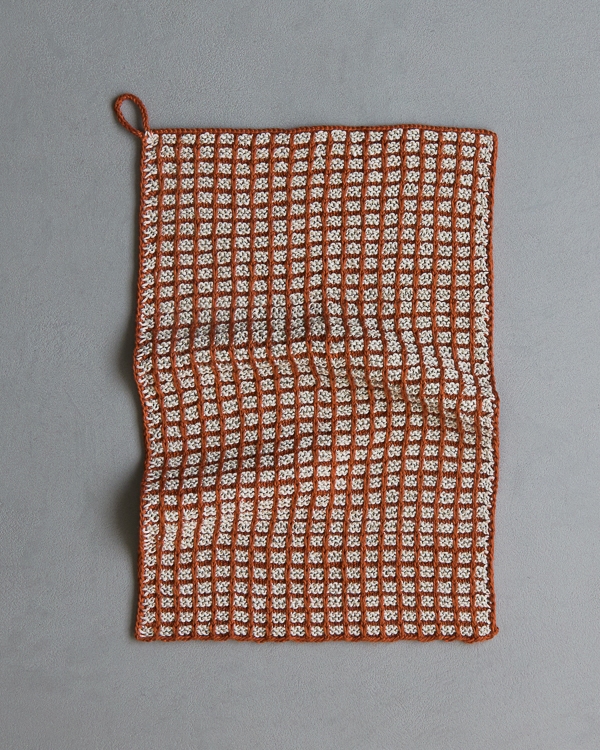
Designed by Purl Soho designer, Whitney Van Nes.
Share your progress + connect with the community by tagging your pics with #PurlSoho, #PurlSohoBusyHands, #PurlSohoSlipStitchDishtowels, and #PurlSohoBlackbirdLinen. We can’t wait to see what you make!
Materials

To make a set of all three Slip Stitch Dishtowels, you’ll need…
- 7 skeins of Purl Soho’s Blackbird Linen, 100% linen. Each skein is 175 yards/ 100 grams.
- Color A: 3 skeins; approximately 418 yards required
- Color B: 2 skeins; approximately 223 yards required
- Color C: 2 skeins; approximately 218 yards required
Note: You can make any one dishtowel with just two skeins of Blackbird Linen in two colors, and with these 7 skeins, you’ll have enough yarn left over to make an additional Triple L Tweed Dishtowel using different colors for A, B, and C.
You will also need…
- US 3 (3.25mm) straight or 20- or 24-inch circular needles
- If using straight needles: Two US 3 double pointed needles for I-Cord
For our samples we used the following colors:
Three-and-One Tweed Pattern
- Color A (loop): Carnelian Orange
- Color C: Queen Anne’s Lace
Basket Stitch
- Color A: Silver Thistle
- Color B (loop): Warm Copper
Triple L Tweed
- Color A: Natural Flax
- Color B: Queen Anne’s Lace
- Color C (loop): Red Radish
Gauge
24 stitches and 32 rows = 4 inches in stockinette stitch
Size
Finished Dimensions: Approximately 11 x 17 inches
Notes
Stitch Multiples
The Three-and-One Tweed and Basket Stitch patterns work over a multiple of 4 + 3 stitches. The Triple L Tweed pattern works over a multiple of 3 + 1 stitches.
Slip Stitches
Slip all stitches purlwise.
Carrying Yarn
When changing colors, carry the new yarn up the selvage in front of the old yarn.
Attached I-Cord Edging
For help with the Attached I-Cord edging, visit our tutorial for the basics and the Finish section of our original pattern for specific instructions for this project.
PATTERNS
Three-And-One Tweed Pattern

With Color A, use a Long Tail Cast On to cast on 79 stitches.
Row 1 (wrong side): Purl to end of row.
Row 2 (right side): With Color C, k3, *slip 1 with yarn in back (wyib, see Notes), k3, repeat from * to end of row.
Row 3: With Color C, slip 1 wyib, k2, *slip 1 with yarn in front (wyif, see Notes), k3, repeat from * to end of row.
Row 4: With Color A, k1, *slip 1 wyib, k3, repeat from * to last 2 stitches, slip 1 wyib, k1.
Row 5: With Color A, slip 1 wyib, *slip 1 wyif, k3, repeat from * to last 2 stitches, slip 1 wyif, k1.
Repeat Rows 2-5 until piece measures 17 inches from cast-on edge, ending with Row 3.
Cut Color C.
Next Row (right side): With Color A, knit to last 2 stitches, k2 onto a double pointed needle.
Finish
With the right side facing you, work an I-cord on the last 2 stitches until the cord measures 3 inches from its base.
Next Row: K1, slip 1 wyib, yo.
Now starting at the base of the I-cord, work an Attached I-Cord (see Notes) down the left selvage. Pick up 1 stitch for every 4 rows (which means picking up 1 stitch at either every Color A or every Color C stripe) until you reach the bottom corner.
Pass the first stitch over the second, cut the yarn, and pull it through the remaining stitch.
Now, with Color A, cast 2 stitches onto a double pointed needle.
K1, slip 1 wyib, yo and with right side facing, pick up a stitch in the bottom right corner. Work an Attached I-Cord up the right selvage to the top corner.
Knit 1 row of a regular, unattached I-Cord, then pass the first stitch over the second so that 1 stitch remains.
Using the double pointed needle with 1 stitch on it, knit the first stitch on the circular needles and bind off. Continue to bind off all the stitches that remain on the circular needles.
Cut the yarn and pass it through the remaining stitch.
Weave in the ends and block your new dishtowel!
Basket Stitch

With Color B, use a Long Tail Cast On to cast on 75 stitches.
Row 1 (wrong side): Purl to end of row.
Row 2 (right side): With Color A, k3, *slip 1 with yarn in back (wyib, see Notes), k3, repeat from * to end of row.
Row 3: With Color A, slip 1 wyib, k2, *slip 1 with yarn in front (wyif, see Notes), k3, repeat from * to end of row.
Rows 4 and 5: Repeat Rows 2 and 3.
Row 6: With Color B, knit to end of row.
Row 7: With Color B, slip 1 wyib, purl to end of row.
Repeat Rows 2-7 until piece measures 17 inches from cast-on edge, ending with Row 5.
Cut Color A.
Next Row (right side): With Color B, knit to last 2 stitches, k2 onto a double pointed needle.
Finish
Using Color B, follow the finishing instructions as for the Three-and-One Tweed, above, except here pick up 2 stitches for every 6 rows (which means picking up 2 stitches at the Color A stripes and skipping the Color B stripes).
Triple L Tweed

With Color C, use a Long Tail Cast On to cast on 82 stitches.
Row 1 (wrong side): Purl to end of row.
Row 2 (right side): With Color B, k3, *slip 1 with yarn in back (wyib, see Notes), k2, repeat from * to last stitch, k1.
Row 3: With Color B, slip 1 wyib, k2, *slip 1 with yarn in front (wyif, see Notes), k2, repeat from * to last stitch, k1.
Row 4: With Color A, *k2, slip 1 wyib, repeat from * to last stitch, k1.
Row 5: With Color A, slip 1 wyib, *slip 1 wyif, k2, repeat from * to end of row.
Row 6: With Color C, k1, *slip 1 wyib, k2, repeat from * to end of row.
Row 7: With Color C, slip 1 wyib, k1, *slip 1 wyif, k2, repeat from * to last 2 stitches, slip 1 wyif, k1.
Repeat Rows 2-7 until piece measures 17 inches from cast-on edge, ending with Row 5.
Cut Colors A and B.
Next Row (right side): With Color C, knit to last 2 stitches, k2 onto a double pointed needle.
Finish
Using Color C, follow the finishing instructions as for the Three-and-One Tweed, above, except here pick up 1 stitch for every 4 rows (which means picking up 1 stitch at every other stripe of color).



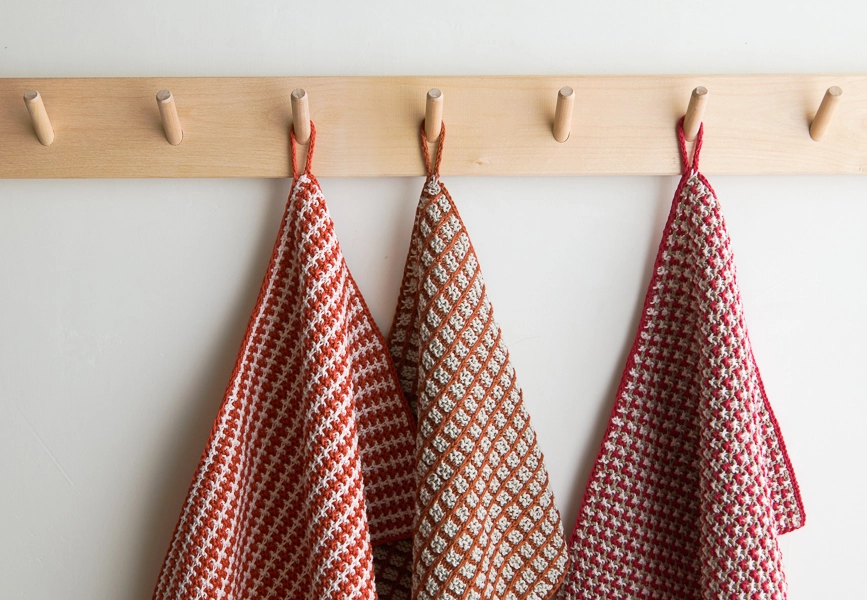


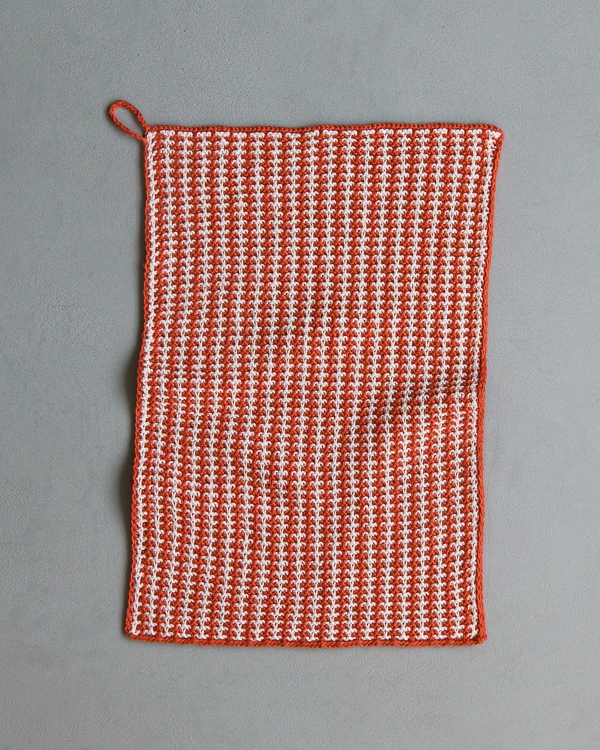



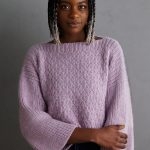
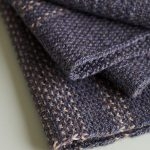

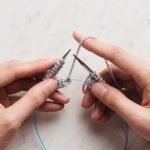
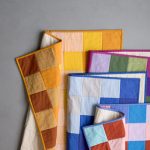

If I wanted to make these slightly smaller could I reduce the pattern by 3 or 6 stitches and still have it work?
Hi Janet,
Thanks for reaching out! You can certainly adjust the size of the dishtowels and make them a bit smaller! When deciding on a cast on number you will want to note that the Three-and-One Tweed and the Basket Stitch works over a multiple of 4 plus 3 stitches and for the Triple L Tweed, works over a multiple of 3 plus 1. So for example, the Basket Stitch cast on (the size as is) you cast on 75 stitches (18 x 4 = 72 + 3 = 75) I would suggest starting off by deciding on the dimensions you would like the dishtowels to be, and if your gauge is consistent with the pattern you can calculate your cast on from there based on these formulas!
I hope this helps and please let me know if you have any more questions!
Gianna
I would like all dishtowels to be in black and white. How many skeins of each color would I need?
thank you,
Pamela
Hi Pamela,
Thanks for reaching out! I think these dishtowels will look stunning in black and white! Depending on which color you would like to be dominant, I would suggest getting either 3 skeins of white and 4 skeins of black or 4 skeins of white and 3 skeins of black!
I hope this helps and please let us know how these turn out!
Gianna
These look great! I’ve been making dish- & wash-cloths for friends & family with cotton yarns.
I’ve never used linen, so I’ll have to order some to try out. Hopefully linen should be long-wearing.
Hi Karen,
Thanks for reaching out! Linen is one of our favorite fibers for dish and washcloths! It is a very absorbent and durable fiber, so these will last a long time!
I hope this helps, happy knitting!
Gianna
how many skeins do you need of each color to make the Three-In-One Tweed dishcloth?
dishcloth?
Hi Marla,
Thanks for reaching out! You only need 2 skeins (2 colors) to make the Three-and-One Tweed Pattern!
Warmly,
Gianna
Gee, these towels are adorable! Really cute and apparently durable. I’d love to make them. But it’s hard to make sense of spending $168 on yarn for 3 dish towels.
Hi S,
Thanks for reaching out! If you don’t want to make all three dishtowels, you can make any one dishtowel with just two skeins of Blackbird Linen in two colors! Also, with these 7 skeins, you’ll have enough yarn leftover to make an additional Triple L Tweed Dishtowel using different colors for A, B, and C. so you can get 4 dishtowels out of the 7 skeins!
Warmly,
Gianna
4 towels for $168? seems a bit expensive. Can cotton be used instead?
Hi Ana,
Thanks for reaching out! You can certainly use cotton for this pattern! I would suggest our Cotton Pure, just be sure to work a gauge swatch prior to beginning to ensure you are consistent with the pattern!
Happy knitting!
Gianna
These are absolutely beautifully done!
Hi, can you tell me what the difficulty level of this pattern is, i.e., beginner, easy, average, intermediate, advanced?
Also, is it at all possible to have that included with each pattern on a regular basis. It would be most helpful.
Thank you!
Hi Leanne,
Thanks for reaching out! I would consider this pattern a beginner to advanced beginner pattern. Although it may look complicated, it is actually very very easy! Slip stitches are knitting’s secret weapon for simple and easy colorwork. You only ever work one color per row, letting the magic of slipping stitches do its thing!
Also, thank you for the suggestion I will certainly pass this along to the rest of the team, however, for the most part, all of our patterns are beginner to intermediate level so we don’t have them labeled.
I hope this helps and please let me know if you have any more questions!
Gianna
I’d love a crochet pattern for this!!
Hi Taylor,
Thanks for reaching out and expressing your interest! I will be sure to pass this along to the rest of the team! In the meantime, you can check out our wonderful collection of Crochet Houseware Patterns!
Warmly,
Gianna
I am nearing the end of the 3 in 1 pattern and I’m finding the finishing steps a bit intimidating. Would there be a video to demonstrate. Thank you!
Hi Gwen,
Thanks for reaching out! We don’t currently have the video tutorial for this step but I will certainly pass along your interest to the rest of the team! In the meantime, is there a specific part you find intimidating? I am happy to help explain!
Warmly,
Gianna
As a new knitter, I’ve loved making these and learning new things. But I’m confused by the finish with starting the attached i-cord. When you K1, slip 1wyib, yo — what is the purpose of the yo? Are you simply moving the yarn to the front or wrapping it all the way around to add another stitch (increasing)? In other words, is the attached i-cord 2 or 3 stitches? Thank you!
Hi Lisa,
Thanks for reaching out! The yo adds another stitch, for more information and how to properly work the yo I recommend checking out our Yarn Over (yo) tutorial!
I hope this clears things up!
Gianna
I’ve viewed the Yarn Over tutorial and am still struggling, as that doesn’t tell me how to yarn over at the end of a row. When I do, the yarn just spins, especially since the icord is just 2 stiches. Am I wrapping all the way around? Help!
Hi Lisa,
Thanks for reaching out! Yes, that is correct you will want to wrap the yarn all the way around so that it is a bit more secure. But the key is that when you turn the work to begin the next row you will want to use your finger to hold the yarn in place so that the yarn over is still intact when you begin knitting!
I hope this helps, happy knitting!
Gianna
The care instructions for the Blackbird Linen are machine wash cold, lay flat to dry. But this is impractical for a dish towel. Have you tried a warm or hot wash & tumble dry?
Hi Claire,
Thanks for reaching out! While I haven’t tried putting the Blackbird Linen through the machine on a warmer temperature setting myself, you certainly could. In my experience with linen, machine washing and drying shouldn’t harm the fibers, but washing on a cold setting and laying flat to dry will extend the life of the finished piece. I’d suggest knitting up a small swatch and putting it through a wash and dry first, to test it before trying it with your finished towels!
Warmly,
Kelsey
I had no idea what it would be like to knit with linen, but I love it!
If I understand the pattern correctly, there will be quite a few yarn ends; is that right?
In the photo, the trim that goes all the way around the dishcloth is the same color (without any variation). Is that because the solid color trim is added at the end?
Also, I’m using 3 distinct colors – which create a pretty pattern, but not the cool little boxes on the Triple Tweed. C=red, B=flax, A=electric blue). Many thanks!
Hi Jenny,
Thanks for reaching out! For this pattern, there is a slip stitch edging that is factored into the pattern, this gives the dishtowels a nice solid edging! Also, you should not actually have many ends to weave in, you will want to carry the yarn up each row, to do that when you are changing colors, you will carry the new yarn up the selvage in front of the old yarn and then begin the next row. You can find this information under the Notes section of the pattern!
I hope this clears things up!
Gianna
I have unequal amounts of yarn remaining for the Triple L Tweed towel. Should the colors A, B, C be used in order or yardage, i.e
A=most yardage
B=second
C=least yardage ?
I don’t want to run out of the least yardage before the towel is finished and I can’t tell from the photo which color uses the least amount of yarn.
Hi Bettina,
Thanks for reaching out. We used 418 yards of Color A, 223 yards of Color B, and 218 yards of Color C for this pattern, so yes, you’re correct about the order of yardage! I think it’s also useful to note that the yardages of Colors B and C are very close to each other, while the yardage for Color A is nearly double. Hope this helps!
All the best,
Lili
Hello,
I already have skeins of Field Linen and would love to make these towels with that yarn. In doing so, what size knitting needles would you recommend?
Thank you!
Hi Kirsta,
Thanks for reaching out. We recommend using size US 2-4 (3-3.5 mm) needles with Field Linen!
All the best,
Lili
Hello,
I’m confused about the gauge used for the towels. The gauge is based on the stockinette stitch but the towels are not knit with that stitch. How many rows in the basket weave pattern equal 4”?
Thanks for the help?
Kim
Hi Kimberly,
Thanks for reaching out, and that’s a very good question! Since there are three different stitch variations that you can make these dishtowels in, we opted just to give a more general gauge. But you can still figure out what your gauge for the basketweave pattern should be from the number of stitches you cast on, as well as the dimensions! Because the 75 cast-on stitches should come out to be about 11 inches, that means you should have about 27.3 stitches in 4 inches in that stitch pattern. As for the row gauge, that actually doesn’t matter as much, since the instructions indicate to repeat Rows 2-7 until you reach the finished length. Hope this helps!
All the best,
Lili
Thank you.
Hi purl soho. I love your store, patterns, yarns. Please help me with this pattern. I’m on my third attempt and this time my after 2cms of length the amount of stitches has grown from 79 to loads and loads more! What am I not understanding about y fwd and y in back! I’ve watched videos etc. Also I’m using a very thin linen so it’s doubled and I’m using 2.75 needles. I’ll try again counting stitches at every row, any tips on the in back in front instruction?
Hi Vicki,
Thanks for reaching out about this. Would you be able to send a photo of your work to us at customerservice@purlsoho.com? It would be helpful to be able to visualize how these stitches are getting added in order to for us to troubleshoot! In the meantime, “wyif” and “wyib” are just telling you where to hold the yarn when you slip a stitch. So for example, if the instructions say: k1, slip 1 wyif, k1, then you would knit one stitch normally, bring the yarn forward as if to purl, slip the next stitch, bring the yarn back to the back of your work as if to knit, and then knit the third stitch. I’ll keep an eye out for your email, and I hope this helps clarify things!
All the best,
Lili
Bonsoir, JE NE COMPRENDS PAS. JE NE PARLE QUE LE FRANCAIS !!!! TRADUCTION GOOGLE !!!! J’AIMERAIS ACHETER LES COTTONS. MERCI À VOUS
Salut Nadia,
Je serais heureux de vous recommander des fils de coton avec lesquels vous aimeriez peut-être travailler. Jetez un coup d’œil aux liens suivants: Cotton Pure, Picnic Cotton, Tulip Cotton, Sunshower Cotton.
Nous avons utilisé ces fils pour tout concevoir, des porte-pots et des débarbouillettes aux serviettes de bain et aux couvertures, donc je pense qu’ils conviendront très bien à vos besoins!
Lili